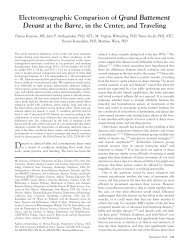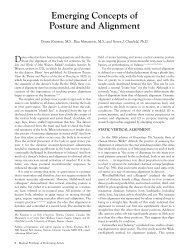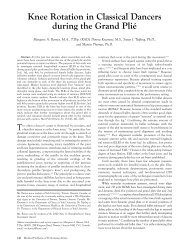And the Dance Goes On - Conditioning-with-Imagery
And the Dance Goes On - Conditioning-with-Imagery
And the Dance Goes On - Conditioning-with-Imagery
Create successful ePaper yourself
Turn your PDF publications into a flip-book with our unique Google optimized e-Paper software.
108 Journal of <strong>Dance</strong> Medicine & Science Volume 5, Number 4 2001<br />
Schafle and colleagues reported that<br />
of 3,251 dance-related injuries,<br />
55% were seen in ballet, 15% in<br />
modern, and 30% in aerobic dancers.<br />
The greatest proportion of ballet<br />
injuries was found in 13 to 18<br />
year olds. The authors reported that<br />
43% of <strong>the</strong> ballet injuries occurred<br />
in dancers younger than 16 years of<br />
age. 55 A closer inspection of <strong>the</strong> intrinsic<br />
factors associated <strong>with</strong> injuries<br />
across genre and age may provide<br />
insight into injury patterns and<br />
<strong>the</strong> barriers to reporting and treatment.<br />
We know that <strong>the</strong> great majority<br />
of injuries in dance are overuse injuries,<br />
1,56 which tend to be accompanied<br />
by pain and discomfort, a<br />
lack of understanding for <strong>the</strong> injury,<br />
and psychological sequelae that<br />
typically are unrecognized or ignored.<br />
54 Theatrical dance has<br />
evolved a “culture of tolerance” concerning<br />
injury and pain that encourages<br />
dancers to dance through,<br />
around, and in spite of injury. If <strong>the</strong><br />
physical injury is ignored, <strong>the</strong> psychological<br />
impact of injury clearly<br />
has not been, and probably will not<br />
be, addressed. With <strong>the</strong> increased<br />
attention to <strong>the</strong> nature and prevalence<br />
of dance injuries, along <strong>with</strong><br />
<strong>the</strong> research on psychological aspects<br />
of athletic injury emanating<br />
from sport psychology, an appreciation<br />
for <strong>the</strong> emotional side of injury<br />
has evolved in <strong>the</strong> dance science<br />
community.<br />
Emotional Reaction<br />
The emotional reaction to injuries<br />
sustained by dancers has been investigated<br />
in three studies to date. 4,7,14<br />
Similar to <strong>the</strong> findings in sport psychology,<br />
dancers’ emotions immediately<br />
post-injury are negative and<br />
progress to more positive feelings<br />
<strong>with</strong> recovery. Macchi and<br />
Crossman examined <strong>the</strong> impact of<br />
injury on 26 professional ballet<br />
dancers between <strong>the</strong> ages of 12 and<br />
21. 4 Retrospective accounts of injuries<br />
were collected through semistructured<br />
interviews, and revealed<br />
that <strong>the</strong> predominant emotions recalled<br />
for <strong>the</strong> initial period after in-<br />
jury (typically ankle and back<br />
sprains) included frustration, fear,<br />
distress, anger, and depression. Several<br />
dancers indicated that <strong>the</strong>y were<br />
initially afraid of <strong>the</strong> reaction of o<strong>the</strong>rs<br />
(teachers, staff, parents, and<br />
o<strong>the</strong>r dancers), and what impact <strong>the</strong><br />
injury would have on <strong>the</strong>ir career.<br />
Watching class provoked feelings of<br />
guilt and anger. During rehabilitation,<br />
reactions varied from optimism<br />
about resuming <strong>the</strong>ir careers<br />
to pessimism about <strong>the</strong> severity of<br />
<strong>the</strong> injury and time needed to recover.<br />
Macchi and Crossman’s qualitative<br />
study provided information<br />
regarding dancers’ recollections of<br />
reactions to injuries incurred over<br />
<strong>the</strong>ir careers. The authors emphasized<br />
that one of <strong>the</strong> main limitations<br />
to <strong>the</strong>ir research is <strong>the</strong> bias<br />
inherent in retrospective self-reports.<br />
Ano<strong>the</strong>r limitation is <strong>the</strong> heterogeneity<br />
of <strong>the</strong> type and severity<br />
of injuries. Consequently, we cannot<br />
discern from this research<br />
whe<strong>the</strong>r <strong>the</strong> reactions noted are to<br />
mild, moderate, severe, overuse,<br />
acute, chronic, or recurrent injuries,<br />
nor whe<strong>the</strong>r reactions to a severe<br />
back strain, for example, are commensurate<br />
<strong>with</strong> those to an ankle<br />
sprain.<br />
Mainwaring and Krasnow interviewed<br />
two young injured dancers (16<br />
and 18 years of age) whose retrospective<br />
accounts of <strong>the</strong>ir chronic debilitating<br />
hip injuries revealed a preponderance<br />
of negative emotions<br />
throughout <strong>the</strong> injury period. 14 For<br />
both, <strong>the</strong>re was a mix of anger, uncertainty,<br />
jealousy, frustration, anxiety,<br />
feelings of alienation, depression,<br />
guilt, self-doubt, disappointment, and<br />
fear. In <strong>the</strong>se cases <strong>the</strong> dancers also<br />
experienced anger, guilt, and distress<br />
about watching o<strong>the</strong>rs dance. In addition,<br />
<strong>the</strong>y continued to perform<br />
movements that evoked pain that was<br />
recognized as a sign that something<br />
was wrong. Both dancers experienced<br />
coping difficulties that resulted in<br />
psychotraumatic distress, manifested<br />
by an attempted suicide in one case<br />
and depressive episodes and disordered<br />
eating in <strong>the</strong> o<strong>the</strong>r. <strong>On</strong>e of <strong>the</strong><br />
dancers also went through bouts of<br />
self-mutilation, in <strong>the</strong> form of selfcutting,<br />
and used clothing to hide <strong>the</strong><br />
symptoms. The severity of <strong>the</strong> negative<br />
psychological impact on <strong>the</strong> lives<br />
and experience of <strong>the</strong>se two young<br />
aspiring dancers is obvious, but one<br />
must be cautious in attributing <strong>the</strong>se<br />
traumatic experiences to <strong>the</strong> injury<br />
occurrence alone. The dancers’ recollections<br />
and perceptions were made<br />
available because of <strong>the</strong>ir willingness<br />
to share <strong>the</strong>ir experiences of injury in<br />
an interview; it was not a psychological<br />
assessment.<br />
Liederbach and colleagues followed<br />
12 professional ballet dancers<br />
(6 female and 6 male, <strong>with</strong> mean<br />
ages of 24 and 26, respectively) for<br />
5 weeks of an intensive season. 7 At<br />
injury onset <strong>the</strong>y found increased<br />
fatigue and inertia, decreased vigor<br />
and energy, and increased secretion<br />
of urinary catecholamines, a measure<br />
of sympathoadrenal activity,<br />
and thus stress. The majority of <strong>the</strong><br />
injuries (75%) were categorized as<br />
“overuse injuries.” The authors concluded<br />
that:<br />
1. The increase in catecholamine<br />
“may be a reaction to performance-related<br />
psychological<br />
and/or physiological stress,” 7<br />
and<br />
2. Injury trends in <strong>the</strong>ir study appeared<br />
to be closely tied to<br />
time-specific onset of performance-related<br />
psychological<br />
and physical stress.<br />
We cannot determine cause and effect<br />
from this study, but it certainly<br />
points to some interesting associations<br />
between <strong>the</strong> physical and psychological<br />
precursors and reactions<br />
to injury. The study of psychophysiological<br />
indicators of <strong>the</strong> stress response<br />
associated <strong>with</strong> injury is an<br />
area that sport psychology is pursuing<br />
currently, and dance science has<br />
embarked upon.<br />
Pain<br />
Pain is an obvious psychosociophysiological<br />
reaction to injury.<br />
What is familiar to <strong>the</strong> dancer and<br />
clinician is finally gaining <strong>the</strong> respect<br />
of scientific investigation.





